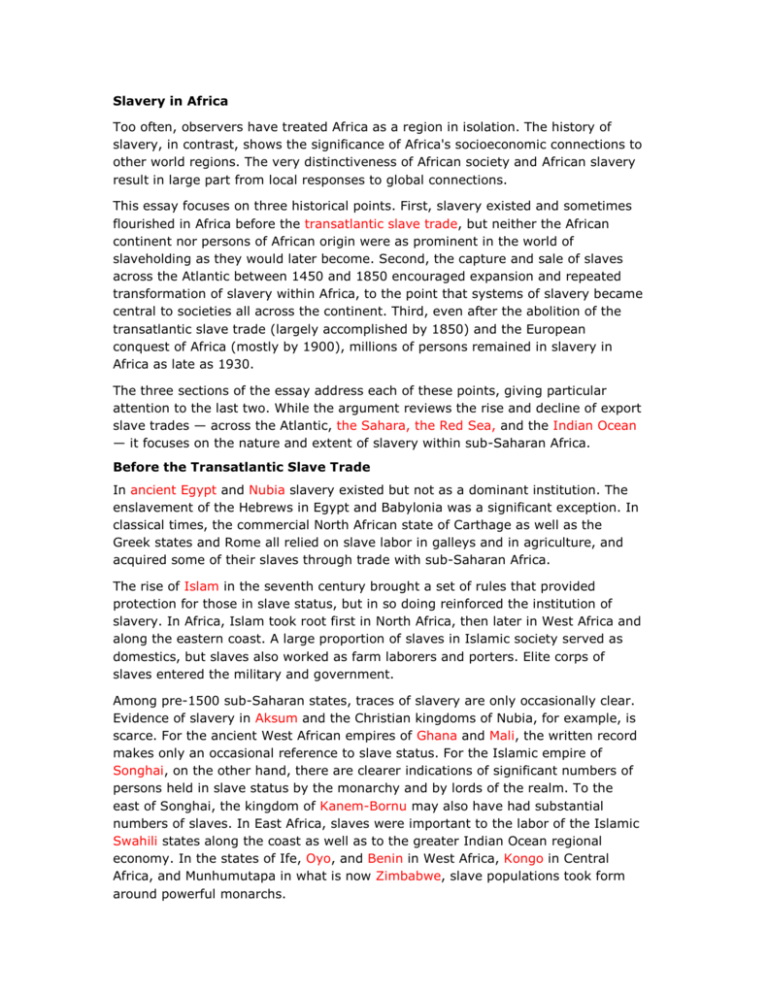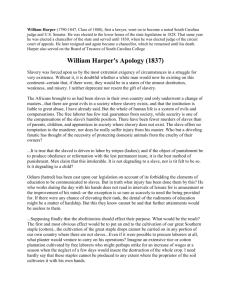
Slavery in Africa
Too often, observers have treated Africa as a region in isolation. The history of
slavery, in contrast, shows the significance of Africa's socioeconomic connections to
other world regions. The very distinctiveness of African society and African slavery
result in large part from local responses to global connections.
This essay focuses on three historical points. First, slavery existed and sometimes
flourished in Africa before the transatlantic slave trade, but neither the African
continent nor persons of African origin were as prominent in the world of
slaveholding as they would later become. Second, the capture and sale of slaves
across the Atlantic between 1450 and 1850 encouraged expansion and repeated
transformation of slavery within Africa, to the point that systems of slavery became
central to societies all across the continent. Third, even after the abolition of the
transatlantic slave trade (largely accomplished by 1850) and the European
conquest of Africa (mostly by 1900), millions of persons remained in slavery in
Africa as late as 1930.
The three sections of the essay address each of these points, giving particular
attention to the last two. While the argument reviews the rise and decline of export
slave trades — across the Atlantic, the Sahara, the Red Sea, and the Indian Ocean
— it focuses on the nature and extent of slavery within sub-Saharan Africa.
Before the Transatlantic Slave Trade
In ancient Egypt and Nubia slavery existed but not as a dominant institution. The
enslavement of the Hebrews in Egypt and Babylonia was a significant exception. In
classical times, the commercial North African state of Carthage as well as the
Greek states and Rome all relied on slave labor in galleys and in agriculture, and
acquired some of their slaves through trade with sub-Saharan Africa.
The rise of Islam in the seventh century brought a set of rules that provided
protection for those in slave status, but in so doing reinforced the institution of
slavery. In Africa, Islam took root first in North Africa, then later in West Africa and
along the eastern coast. A large proportion of slaves in Islamic society served as
domestics, but slaves also worked as farm laborers and porters. Elite corps of
slaves entered the military and government.
Among pre-1500 sub-Saharan states, traces of slavery are only occasionally clear.
Evidence of slavery in Aksum and the Christian kingdoms of Nubia, for example, is
scarce. For the ancient West African empires of Ghana and Mali, the written record
makes only an occasional reference to slave status. For the Islamic empire of
Songhai, on the other hand, there are clearer indications of significant numbers of
persons held in slave status by the monarchy and by lords of the realm. To the
east of Songhai, the kingdom of Kanem-Bornu may also have had substantial
numbers of slaves. In East Africa, slaves were important to the labor of the Islamic
Swahili states along the coast as well as to the greater Indian Ocean regional
economy. In the states of Ife, Oyo, and Benin in West Africa, Kongo in Central
Africa, and Munhumutapa in what is now Zimbabwe, slave populations took form
around powerful monarchs.
It is difficult to assess the extent of slavery outside of these major states prior to
1500 because of the lack of data. But the earliest written reports by visitors from
Europe and North Africa and the later anthropological records suggest that various
kinds of slavery existed in smaller as in larger polities.
It is also difficult to assess the nature of servility during this era, and to know
whether it was equivalent to chattel slavery. By the beginning of the twentieth
century, according to the descriptions of European writers, African societies had
developed many different types of servitude. But some of this variation may have
developed over time, in response to the imposition of chattel slavery in the
plantations and mines of the Americas (see Slavery in Latin America and the
Caribbean).
During the Transatlantic Slave Trade, 1450-1850
Portuguese and Spanish holdings of African slaves expanded with the maritime
voyages of the fifteenth century, then grew moderately until, after 1650, the
transatlantic trade exceeded the slave trade across the Sahara and Red Sea.
Portuguese and then Dutch purchasers focused in Senegambia, Kongo, Angola, and
Sierra Leone. Africans' willingness to participate in the export of slaves varied. The
kingdom of Benin, for example, eventually withdrew from the slave trade, but in
Kongo and Senegambia those willing to profit from capture and export of slaves
became dominant. These and then other African societies developed the means to
capture, feed, finance, and transport captives for sale to European buyers.
As the trade expanded, Europeans developed a preference for males and were
willing to pay more for them. Africans, in contrast, paid higher prices for female
slaves, who were preferred because they could be used as domestic and
agricultural laborers, as concubines, and as bearers of children. They were also
considered easier to control than men. As prices diverged, the European and
African markets for slaves grew in tandem. Their parallel expansion meant that,
from the seventeenth century, the number of persons in slavery in Africa roughly
equaled the number in the Americas.
Between 1700 and 1800, for the western coast of Africa from Senegal to Angola,
the export of massive numbers of primarily male slaves led to both overall
population decline and the dramatic increase in female slavery. Thus the
transatlantic slave trade had not only demographic consequences for African
societies but also economic and social ones.
At the turn of the eighteenth century the Bight of Benin was the principal region of
slave supply. Wars among competing coastal states supplied as many as 15,000
slaves per year for export. Many of these slaves spoke the Gbe language and
practiced the religion of Vodun (a predecessor of Haitian Vodou). But as 5 percent
of the population were exported each year in chains, the population declined and
captives became more expensive to collect and deliver. As a result, prices of slaves
in the Bight of Benin rose dramatically between 1690 and 1730. As population
declined and prices rose in one area, other areas were drawn into the slave trade:
the Bight of Biafra (southern Nigeria), Sierra Leone, the Gold Coast (now Ghana),
the Republic of the Congo, and Angola. As traders all along Africa's west coast
began to deliver captives, the excess of males delivered across the Atlantic led to a
changed population structure in the homeland. Women exceeded men by a
substantial proportion in West and Central Africa, with an average of 100 adult
females for every 70 adult males. In areas such as Angola and the Bight of Benin,
the ratio reached two adult women for every man.
Most captive women were sold into slavery and kept by families. A huge system of
female-dominated family slavery arose all along the African coast during the
eighteenth century. It expanded as long as demand for slaves in the Americas
expanded — that is, until the end of the eighteenth century. Women worked as
servants or in the fields. They were without family except for their owners and their
children, and the children were property of their owners. This century of numerical
dominance but social inferiority for women had a lasting influence on the institution
of marriage and on the sexual division of labor in societies along Africa's west
coast.
Between 1800 and 1850 two distinct but related developments led to both an
increase in the number of persons held in slavery in Africa and the overall
transformation of Africa systems of slavery. The first development was the growing
demand for slaves in the Muslim Mediterranean and the lands bordering the Indian
Ocean, beginning in the late eighteenth century. Perhaps this demand reflected the
general growth in commercial activity; perhaps it reflected simply the spread of the
system of slave labor from the Atlantic Basin. It remained primarily a demand for
female slaves, who served largely as domestics. Societies of the northern savanna
and the Horn of Africa, therefore, had populations with an excess of males, in
contrast to the excess of females in societies along the Atlantic.
The second development occurred along the west coast of Africa, where the decline
of slave exports after the gradual abolition of the transatlantic trade led to
expansion and transformation of the African system of slavery. African sex ratios
tended to equalize as the proportion of exiled males declined. Slaves were now
both male and female, and they lived not in the households of their masters but in
separate villages. For the continent as a whole, the expansion of this new system
of slavery coincided with ongoing population decline. The number of captives
exported from West Africa declined, but exports remained high in the Republic of
the Congo and Angola, and exports actually rose along the Sahara fringe as well as
along the Horn and the east coast of Africa. As population declined and levels of
enslavement rose, plantation slavery and slave villages became more common in
many areas in Africa. In southern Africa, slavery declined under British colonial rule
in the west but expanded in the east, where slaves were captured for export to
lands around the Indian Ocean.
African Slavery After the Abolition of the Transatlantic Slave Trade
Slave trade across the Atlantic had virtually halted by 1850. But the various
regions of the African continent continued to feel heavily the impact of
enslavement and slavery for most of the next century. The result was that Africa in
the late nineteenth century had more people in slavery than at any previous time.
The final great emancipations of the Americas — the United States in 1865, Cuba
in 1886, and Brazil in 1888 — left Africa, and especially the Sokoto caliphate in
northern Nigeria, holding the world's principal enslaved populations.
Slave exports across the Indian Ocean, the Sahara, and the Red Sea reached their
peak in about 1850, then declined at varying rates until the end of the century.
During this time, some enslaved Africans were carried across the Red Sea to build
an expanded pilgrimage site at Mecca, in Saudi Arabia; others were carried on
steamers through the Suez Canal, bound for Istanbul and Izmir.
In coastal West Africa, slavery expanded on plantations producing export
commodities such as palm oil. The result was social turmoil, as slaves revolted in
several regions from Calabar to Dahomey during the 1850s. Although the revolts
were suppressed, they also set new limits on the exploitation of slaves. In the
Republic of the Congo and Angola, exports finally halted around 1850, though
enslavement for local purposes continued. In the northern savanna, exports of
slaves peaked in the mid-nineteenth century, but the number of captives exceeded
what could be explained as a by-product of export trade. In regions of the upper
Niger Valley, there were repeated reports that the majority of the region's
population was in slavery, and that the slaves were principally female: they
produced grains and textiles for the domestic market and leather goods for export.
Captive workers in the Sahara mined salt and produced dates and grains in oases.
Slave labor forces in Senegal produced peanuts for export.
In the Horn of Africa, the continued export of slaves to Arabia left large holdings of
slaves within Africa. Exports of slaves and a population decline also continued in
East Africa, where European purchasers, based in Madagascar and the Mascarene
Islands, maintained a high demand for slaves into the 1880s.
In short, the world markets for slave labor and for the goods produced by slaves
remained strong in the middle and late nineteenth century, and these markets
supported slavery and slave trading in Africa. The European powers poised to
invade the continent pointed to the persistence of African slavery to justify
colonization. Thus the Berlin Conference of 1885, convened as an antislavery
meeting, in fact set the rules for the European conquest of Africa (see Scramble for
Africa) .
Between 1890 and 1940 the European colonial powers strengthened their grip on
African lands and African societies and preached a doctrine of antislavery. The
result was not, however, immediate emancipation. Large-scale slave raiding came
to an end because the European powers had monopolized the use of armed force.
But slavery itself continued for millions of Africans until the eve of World War II.
The European conquest of Africa took place, in large measure, between 1880 and
1900. By 1900 African armies had been routed and European hegemony was
established nearly everywhere except Ethiopia, Liberia, Morocco, and parts of the
Sahara. Great numbers of slaves took their liberty with the change in power, and
European authorities decreed, for the most part, that slave raiding was henceforth
prohibited. Yet only infrequently were African slaves emancipated. The slaves of
Madagascar were liberated after the 1897-1898 French conquest, but British
conquests during those same years did not lead to the emancipation of slaves in
either Sudan or the Sokoto caliphate.
With the establishment of colonial rule, slavery was reformed but not abolished.
Slave owners, no longer able to hope for new captives, put higher value on infant
and child slaves; both the prices and the level of nourishment of children
increased. Workloads for adult slaves decreased accordingly, as their survival now
became more important. In Ethiopia, for instance, the abolition of slave trade
during World War I (when Ethiopia sought European approbation of its regime in
order to avoid conquest) brought a rapid rise in prices of child slaves. The accounts
of colonial ethnographers who visited African societies after 1900 describe systems
that protected the rights of slaves; these rights had been expanded just as slave
raiding had ended. The colonial era African system of slavery without slave raiding
corresponded in many ways to antebellum slavery in the United States.
Instead of emancipation, European rulers in Africa resorted to gradual and indirect
means to end slavery. One was through the courts: slaves who claimed
mistreatment could appeal for redress or emancipation in colonial courts. Slaves
could purchase their own freedom. In British colonies, the administration tended to
declare that the state no longer recognized the institution of slavery. This
approach, first implemented in British India in 1843, prevented slave owners from
appealing to the state to retrieve escaped slaves; it also prevented slaves from
challenging their condition, since the state argued that slavery no longer existed.
Still another device was the legislation of the emancipation of infants born after a
given date; in Sierra Leone, for example, the date was 1928. Further, as Paul
Lovejoy and Jan Hogendorn have shown, the institution of concubinage continued
beyond the era of slavery. Northern Nigerian landowners continued to pressure
poor families to provide young women for their harems.
The distinction between slave and master in Africa was not, as in the Americas,
typically based on a distinction in race. But indicators such as name, language,
scarification, dress, and manners all distinguished the identity and social status of
slaves from those of their masters. Thus, while the heritage of slavery was kept
alive in the Americas through discrimination by race, the heritage of slavery
remained alive in Africa through discrimination by class. African countries, though
millions of their inhabitants are descendants of slaves, have no holiday to celebrate
the emancipation of slaves. The lack of a clear act of emancipation helped to
propagate relations of servility into the mid- and late twentieth century.
1
1"Slavery in Africa," Microsoft® Encarta® Africana. ©&(p) 1999 Microsoft
Corporation. All rights reserved.









